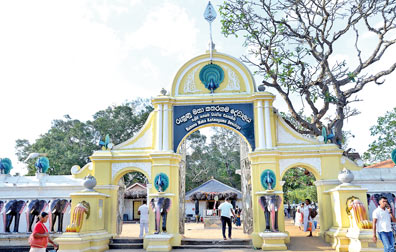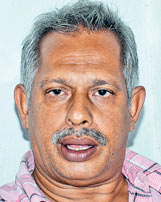New Year in Kataragama
by P. Krishnaswamy
It was a bright, sunny day in Kataragama and pilgrims, in a rather
elated state, were everywhere - in and around the Maha Devalaya, in
smaller temples of other deities in the vicinity, including the temples
of Lord Skanda’s divine consorts Valliamma and Theivanai Amma; at the
Muslim ‘Dharga’ at flower and fruit stalls, at the Kirivehera and at the
Menik Ganga, the sacred river that flows by the side of this city.
 |
| Ruhunu Maha
Kataragama Devalaya |
 |
| Kavadi Dance |
The evening was more picturesque with colourful illuminations and
decorations in and around the temples. Thousands of clay oil lamps with
their flickering lights bracketing the road to the Kiri Vihara.
Devotees of the God Kataragama, not only Buddhists and Hindus but
also those belonging to other faiths flocked to the sacred city in their
thousands on Thursday, a day ahead of the New Year, to invoke the
blessings of God Skanda for prosperity and well-being. Politicians,
prominent businessmen, senior government officials and also foreign
tourists were among them.
The historical story of Kataragama is interestingly related to King
Dutugemunu. According to records, King Dutugemunu reigned from 161 to
137 AD. The Kataragama Devala was constructed during that period. The
poet ‘Kandamala kavya’ has ingeniously described the affiliation between
the reign of King Dutugemuna and God Kataragama in a creative, poetic
form.
According to legend, the Devalaya, which was located primarily on top
of a mountain was re-established in its current location by King
Dutugemunu.
Location
The story unfolds that the King shot an arrow from the top of this
mountain and decided on the location for this sacred temple, based on
where the arrow landed. According to Sinhala legend, the King made a vow
to God Kataragama offering a temple in return for the His blessings to
gain victory in the war against the then reigning King Elara.
It is believed he piously offered the ‘Kataragama Deva Maligaya’ to
God Kataragama consequent to his victory.
The Kataragama Devalaya bears an iconic significance in the history
of Sri Lanka in that it is respected the world over as a multi-religious
place of pilgrimage.
The multi-religious places of workship here include the Ruhunu
Kataragama Maha Devalaya, Kirivehera, Bodhiya and other temples and a
Muslim mosque.
The multi-religious nature of the sacred city is also reflected in
the fact that although all the auspicious times are decided on by the
‘Kapu Mahaththayas’ in the temples, the beginning of the 15-day Esala
festival is symbolically marked with a flag-hoisting at the mosque, that
houses the tombs of two Muslim saints intimately associated with Islamic
lore.
During the spectacular festival of colour, light and sound and
caparisoned elephants, held in mid August, the streets of Kataragama are
replete with parades, dances and rituals including fire-walking, cheek
and tongue piercing, hanging from iron hooks and Kavadi dancing (dancing
with an arched pole decorated with peacock feathers on the shoulders).
The centuries-old ‘Pada yathras’ or foot pilgrimage from all parts of
the country through wild elephants and wild beasts infested jungle
terrain lasting weeks or months also continue during the festive season,
although the jungle terrain at present is relatively safer.
 |
 |
 |
| Swamy Pumanand
Giri |
Anuradha
Ekanayake |
P.M.M. Rafeek |
The Kataragama Museum in the vicinity also sheds some light on the
history of the shrine and events connected to it. The museum has rare
miniature statues and documents.
Valliamma
Administrative Secretary and Secretary to the Basnayake Nilame of the
Maha Kataragama Devalaya Anuradha Ekanayake told the Sunday Observer
they had anticipated a large number of pilgrims during the New Year
season and all arrangements were made to provide facilities to devotees
to worship God Kataragama, and also provide them with sanitary and
health care and other security arrangements in consultation with the
police and government authorities.
There are over one million pilgrims daily during the Esala festival
season and the Maha Devala also receives donations and contributions
from pilgrims, he said.
Speaking about the legend of the Maha Devala and the Theivanai Amman
temple, the North Indian Swamy in-charge of the Theivanai Amman temple,
Swami Purmanand Giri, said Lord Muruga also known as Skanda and by
several other names came to Sri Lanka thousands of years ago to kill the
demon King Asura and after achieving his mission, fell in love with
Valliamma, who belonged to the local aborigine Veddah community.
He stayed back without returning to his divine consort Devasena also
known as Theivanai Amman, in India.
Theivanai Amman sent a wandering Sanyasin (monk with divine powers )
to Sri Lanka to bring back God Skanda. The Sanyasin reached Kataragama
and unable to find God Skanda, started a ‘Tapasya’ ( meditation) and
meditated for 12 years and finally found Lord Skanda and Valliamma.
Shortcomings
At that point of time, Goddess Theivanai Amma also came to Sri Lanka
and was angered when God Skanda refused to go back to India with her.
That is why her temple is on the left side of the Maha Devalaya while
the Valliamman temple is opposite, with the God directly facing her,
Swamy Giri said.
He highlighted the shortcomings on performing poojas and other
rituals at the Maha Devalaya. It is a Hindu temple and hence Hindu
priests should be the main priests performing the poojas and other
rituals. But, unfortunately, this is not so, he said.
During festival time, the Theivanai Amman Temple administration
provides food to 10,000 - 20,000 pilgrims, which includes breakfast,
lunch and dinner, however, the food goes waste, when people who request
for meals in advance do not turn up. The temple authorities do not like
any food going waste and devotees should turn up when they request food
in advance, he said. Anybody will be provided meals free, if they
request in advance, he said.
A Norwegian tourist and a five-member Norwegian team, led by Lars A
Rinde, Managing Partner of a chartering firm said, “Despite the fact
that Norway has been recognised by the UN as the best country to live in
and we love Sri Lanka, not only because of the excellent climate but
also for other reasons such as attitude and hospitality of the people.
“They are united and live in harmony, which we appreciate. Religious
culture and the heritage blend at this shrine, although we do not know
much about the culture and heritage of Hinduism or Buddhism,” Lars Rinde
said. He found the peacocks, elephants and other wild life fascinating.
The manager of the mosque in Kataragama, P.M.M. Rafeek, said on the
first day of the 15-day Esala festival, religious leaders and government
officials visit the mosque to hoist flags to mark the beginning of the
festival. Religious activities in the mosque do not bar any other
religious community. Priests and devotees of other faiths, senior
government officials and political leaders also visit the mosque. All
religious activities and events are planned and performed collectively.
A saint known as Palkudi Bawa is believed to have come here 428 years
ago and his tomb is in the shrine, Rafeek said.
Portions on the history of Kataragama and the religious rituals are
based on the book ‘Pimbara Kataragama’ published by the Kataragama
Devalaya administration. |

